What is International Targeting, and How Can You Use It For International SEO?

International targeting, or geotargeting, is the process of optimising your website to attract traffic from a specific geographic location – i.e. from different countries – or from users that speak a different language.
It’s part of a wider international SEO process, which is essential for businesses that do digital custom in multiple regions around the globe.
There are a few steps you should take to do this effectively and we’ve gone into more detail about those below:
- Do you need international targeting?
- Are you targeting a country or a language?
- Optimising your URL structure for International SEO
- Using hreflang to language tag your pages
- Tailoring your content to your target audience’s language or culture
Do you need international targeting?
First things first, it’s important to establish whether you actually NEED international targeting.
International targeting is used to create a completely internationalised version of a site, and most business looking to do this are trying to do one or two things:
- Target users and traffic that speak another language
- Target users and traffic in another country or region
If this all applies to you, then international targeting may well be your way forward.
Are you targeting a specific country or language?
When kick-starting your international SEO strategy, you first need to define your objective in terms of ‘country’ verses ‘language’.
Ask yourself, are you trying to target users that speak a specific language, or users that live in a specific country or region? It’s an important consideration, because your strategy could be de-railed by confusing the two.
While many countries have just one official language, there are plenty of others that have multiple. Take Switzerland, for example, which has four official and widely-spoken languages – French, German, Italian, and Romansh.
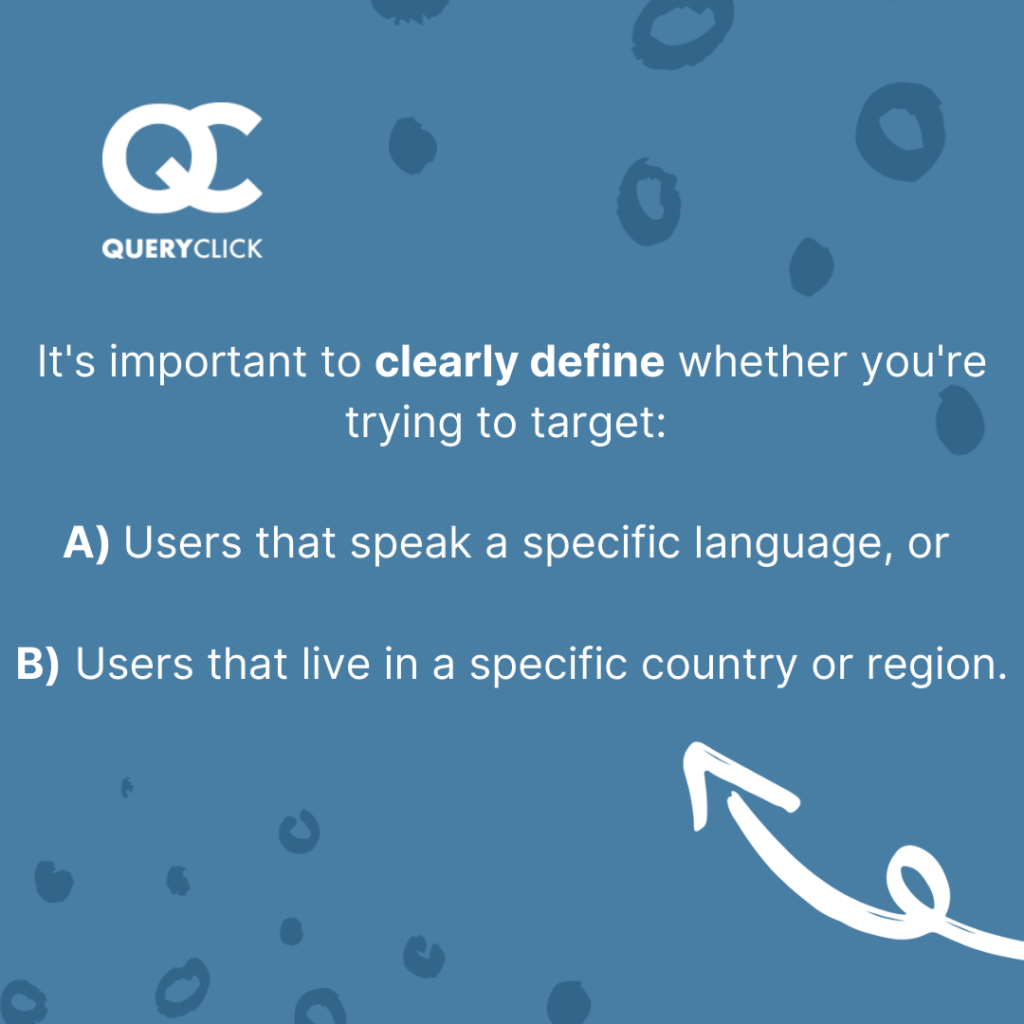
There’s little point targeting a website for a Swiss audience but only optimising for one of these languages. You’ll likely miss out of a significant amount of traffic from users that don’t understand it. International SEO and targeting for somewhere like Switzerland must take language-variance into consideration to be successful.
On the other hand, if you’re targeting all users who speak a certain language, targeting your website to that language’s country of origin is also not best approach.
Let’s say you’re trying to attract Spanish-speaking visitors. You may think that targeting your website to Spain as a country is a good first step. In reality, you risk missing out on traffic from the vast majority of Spanish speakers that DON’T live in Spain – like most of South America.
Once you’ve decided whether you’re targeting a country, a language, or even both, you can proceed to the next step.
Optimise your URL structure for International targeting
One of the fundamental steps of international targeting is optimising your website’s URL structure for an international audience.
There are a few URL structures that webmasters can deploy to target a particular country or language.
Optimising your URL structures for different countries
To optimise your URL structure for targeting different countries, you can use any one of the following:
- ccTLD – a country code top-level domain that uses two-letter codes to indicate to users and search engines what country, region, or territory their website is registered in.
- Subdomain – a separate ‘third-level domain’ where internationalised content is hosted
- Subfolder – a separate subfolder of the root domain where internationalised content is hosted
- Different domain – using a different domain altogether for internationalised content
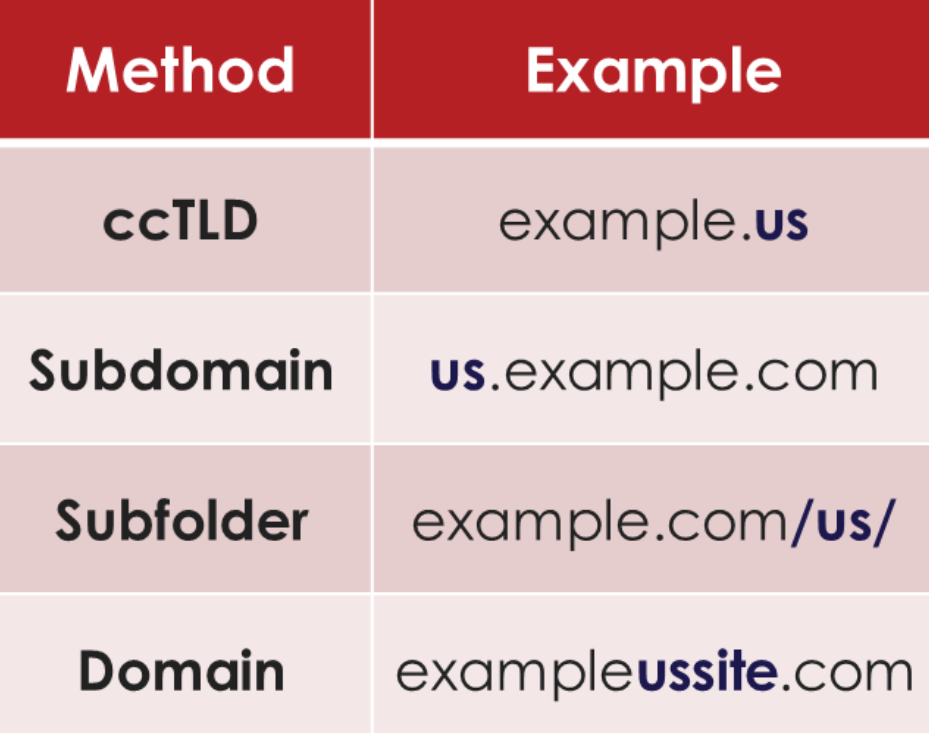
Every technique has its pros and cons, and it’s essential to weigh these up against your objectives to help decide which is right for you.
Country code top-level domains (ccTLD’s) send the clearest signal to search engines and are the best and easiest way to rank in a specific location. However, they can be costly to maintain and each of your different international sites is treated by Google independently, meaning they’ll have to independently accrue authority.
Subdomains are again easier to maintain than ccTLDs but also send a weaker signal to search engines. They’re also often treated as separate websites to the root domain, diluting domain authority.
Subfolders are far easier to manage than ccTLDs and consolidate your domain authority. However, they also send a weaker signal to search engines.
If you’re an international business looking to break into the German market, you could use one of the following:
- example.de (ccTLD with the German two-letter country code)
- de.example.com (subdomain with the German two-letter country code)
- example.com/de/ (subfolder for German localised content)
- exampledeutschland.com (using a completely separate domain altogether)
Optimising your URL structures for different languages
If you want to target users that speak a specific language, you can use a global top-level domain (gTLD) combined with a language parameter.
For example:
- example.com/?lang=fr-fr
Language parameters are a quick and easy way to direct visitors to the appropriate version of your website. It’s not recommended to rely on these alone for a multilingual site, however they can be used in combination with the tactics in the previous section.
For example:
- fr.example.com/?lang=fr-fr
This clearly indicates a website that is the French-language equivalent of example.com, both using a subdomain to host the French version of its content and a French language URL parameter.
Use hreflang to ‘language tag’ your pages
Once you’ve set up your differently-targeted websites, you may end up in a position where you have a variety of pages on the same root domain that contain similar content – but in different languages.
Here you can use hreflang tags to tell Google what language you’re using on a specific page, ensuring they can be served to users searching in that language.
Hreflang tags are added to your page header HTML and are formatted like this:
<link rel=“alternate” hreflang=“lang_code” href=“url_of_page” />
“lang_code” is where you put a supported language or region code (for example, ‘fr’ for French). You can also use “x-default” to match the page with any users searching in a language that’s not explicitly listed by a hreflang tag on the page (i.e. if you don’t have a page in that language).
“urls_of_page” is where you put the fully-qualified URL of the version of this page for the specified language/region
To employ these correctly, you have to put a set of hreflang tags in the HTML of every page – including itself.
For example, let’s say you had the following language-variant pages:
- https://en.example.com/ – a generic English language homepage containing product and pricing information about your product
- https://en-gb.example.com/ – an English language homepage that displays pricing information in pounds sterling
- https://fr.example.com/ – a French language homepage that displays pricing in Euros
- https://www.example.com/ – a ‘default’ page with no target language or locale. It may include selectors to let users pick their language and region
To set up your hreflang tabs correctly, you’d have to put the following HTML in the section of EACH of the pages above:
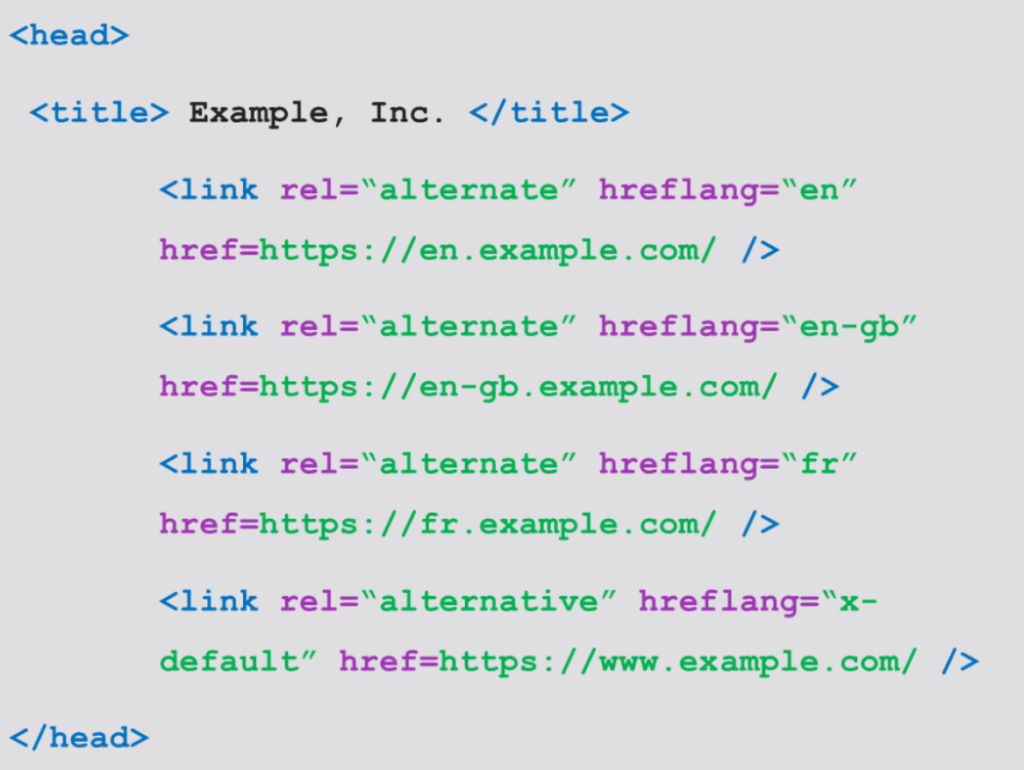
If deployed correctly, Google can now return the appropriate language result for a user according to their browser settings.
How to check your hreflang tags are set up correctly
You can use Google Search Console to identify any hreflang issues, using the International Targeting report to check your tags are implemented correctly.
You can find this under the ‘Legacy tools and reports’ menu item on the left, and is broken up into two sections:
- Language, to monitor the usage and of hreflang tags on your site
- Country, to set a site-wide country target for your entire site, if desired
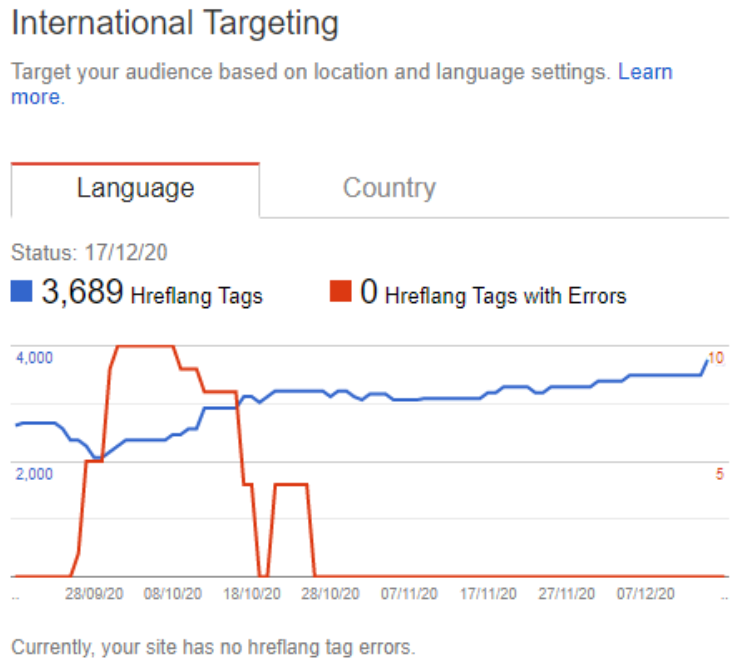
Tailor your content to your target audience’s language or culture
Arguably the most important step is to ensure your content is localised to your target audience. If you’re targeting a specific country, this means using the local language (there may be more than one), currency, and time zone, as well as writing with local customs and culture in mind.
If you’re targeting speakers of a specific language, really making sure you’re properly translating your content is key.
Accurately translating your content
If, and when, you’re translating your content, never rely on a machine translator to do this. This is a highly inaccurate method of translation that provides a poor user experience and is suboptimal for SEO targeting too.
Instead, you should always use some someone who is a native of fluent speaker of the language you want to target, as well as the language of your original content.
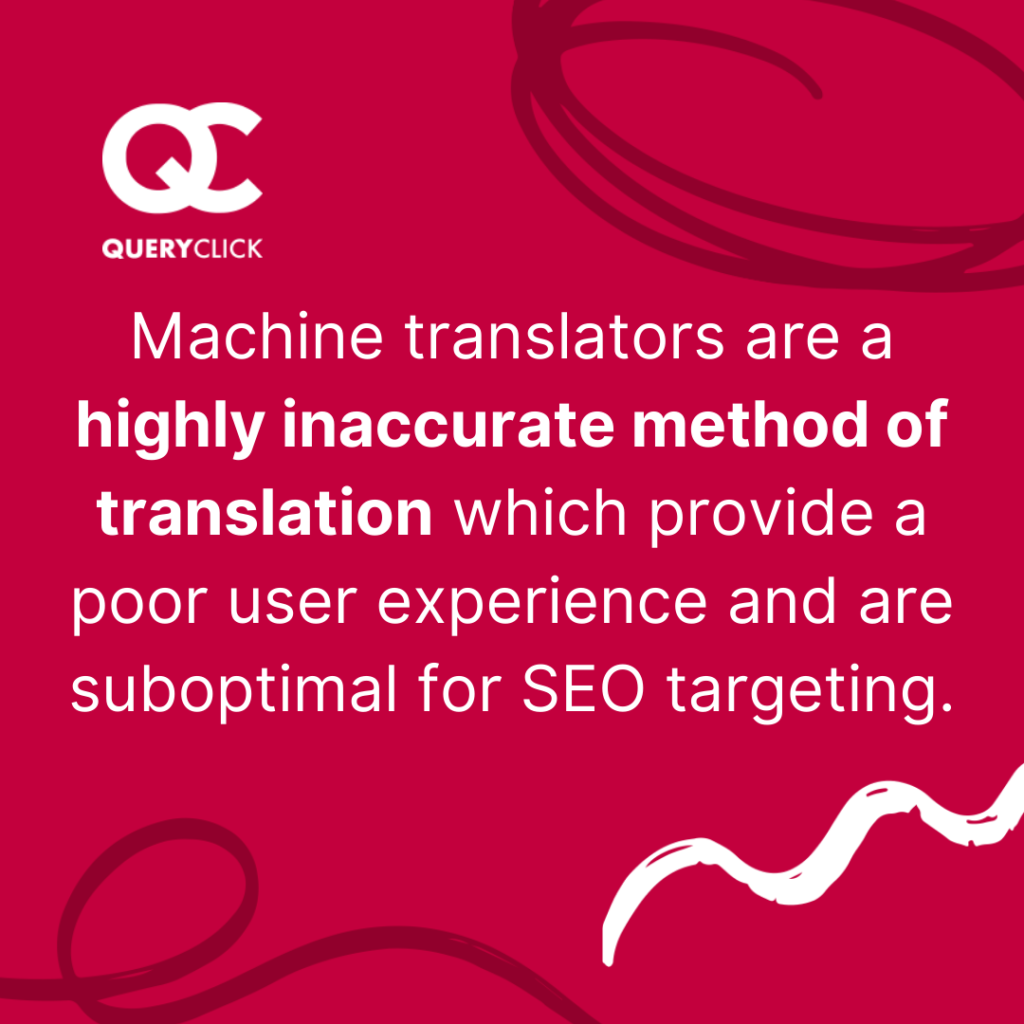
The same rule applies if you’re creating content for a specific country or region – it’s always best to consult someone who either lives in or is familiar with the target culture to make it as localised and familiar to your audience as possible.
This is essential to providing the best user experience and earning the most organic traffic.
Localising your language, imagery, and design
Targeting your content to a specific country or language goes beyond simply translating the words on your page. Ensuring your content is relevant from a cultural and design perspective is important too.
Every culture has different tastes in things like music, colours, imagery, and design. Making sure that yours are specific to your target audience is essential to doing localisation well.
Let’s look at some examples of how it could go wrong:
- Referencing inappropriate holidays or customs – for example, including visual or verbal references to region-specific holidays – like Christmas – that your target audience don’t celebrate
- Using the wrong navigational direction for a language – some languages, like Arabic, read from right to left rather than left to right. Using the ‘traditional’ left-to-right navigation alignment on Arabic webpages can make it visually unpleasant or difficult to use for native speakers.
- Using images that contain cultural taboos – featuring pictures of people in their swimwear or in other more revealing clothing may be fine in your culture but may cause offense in another. Being aware of cultural norms is an essential step to getting your imagery right.
- Using humour that doesn’t land – different cultures and languages have varying understandings of what’s funny and what’s not. Just because your content contains a joke that’s funny in its original language, and to that target audience, doesn’t mean it will land well or be understandable to another.
You may think these are just little considerations, but things like content familiarity and user psychology are essential to delivering a good user experience and earning more organic traffic.
Foreign language SEO
Just as it is for content in your own language, ensuring your pages are optimised for the best performance in organic search results is essential to earning organic traffic in another. But identifying the right keywords to target in another language presents challenges of its own.
Don’t assume that users speaking a different language use the same search terms as you. You need to research your keywords rather than just translate them.
For example, as the French translation for “car insurance” is “l’assurance automobile”, you might think this is the best keyword to target on an insurance website geared towards a French-speaking audience. In reality, the most popular search term is “auto assurance,” so you’d be missing the mark.
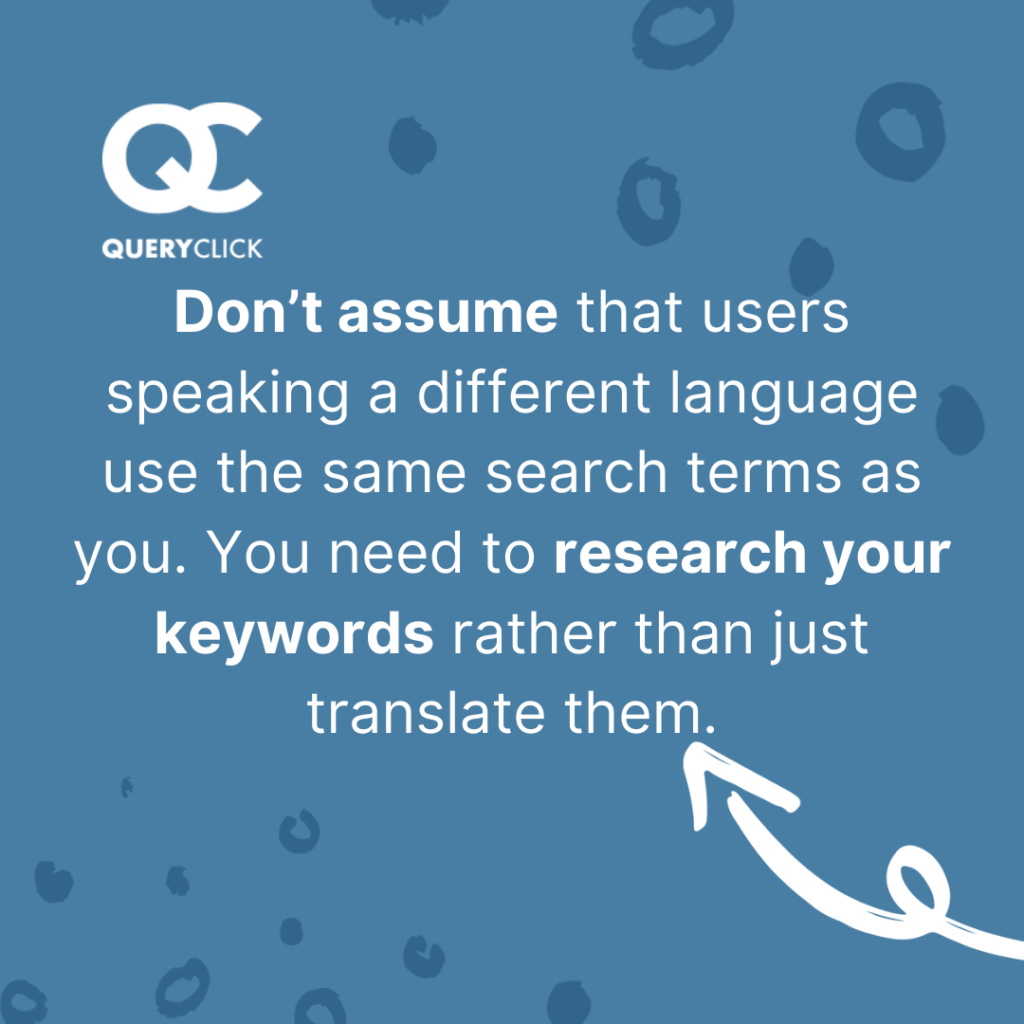
If you’re targeting users by language but not necessarily their country-of-origin, understanding how the same language can differentiate by region is important too. For example, the word “guagua” means “baby” in Chile, but refers to a “bus” in Cuba, The Dominican Republic, and Puerto Rico. Although these countries are all Spanish-speaking, there are notable regional and cultural differences for individual words.
Let’s use Arabic as another example. Although most of the Arabic-speaking world will understand Modern Standard Arabic, spoken-Arabic varies hugely between regions like the Gulf and North Africa – to the extent where one might have difficulty understanding the other.
Being aware of these challenges while considering your target users’ search behaviour can make all the difference to the effectiveness of your localised SEO strategy. These are the kind of insights only a native speaker can provide, so while you can use direct translation and keyword research tools to build an initial list, it’s important to check-in with someone who’s familiar with the target language or culture to get them right.
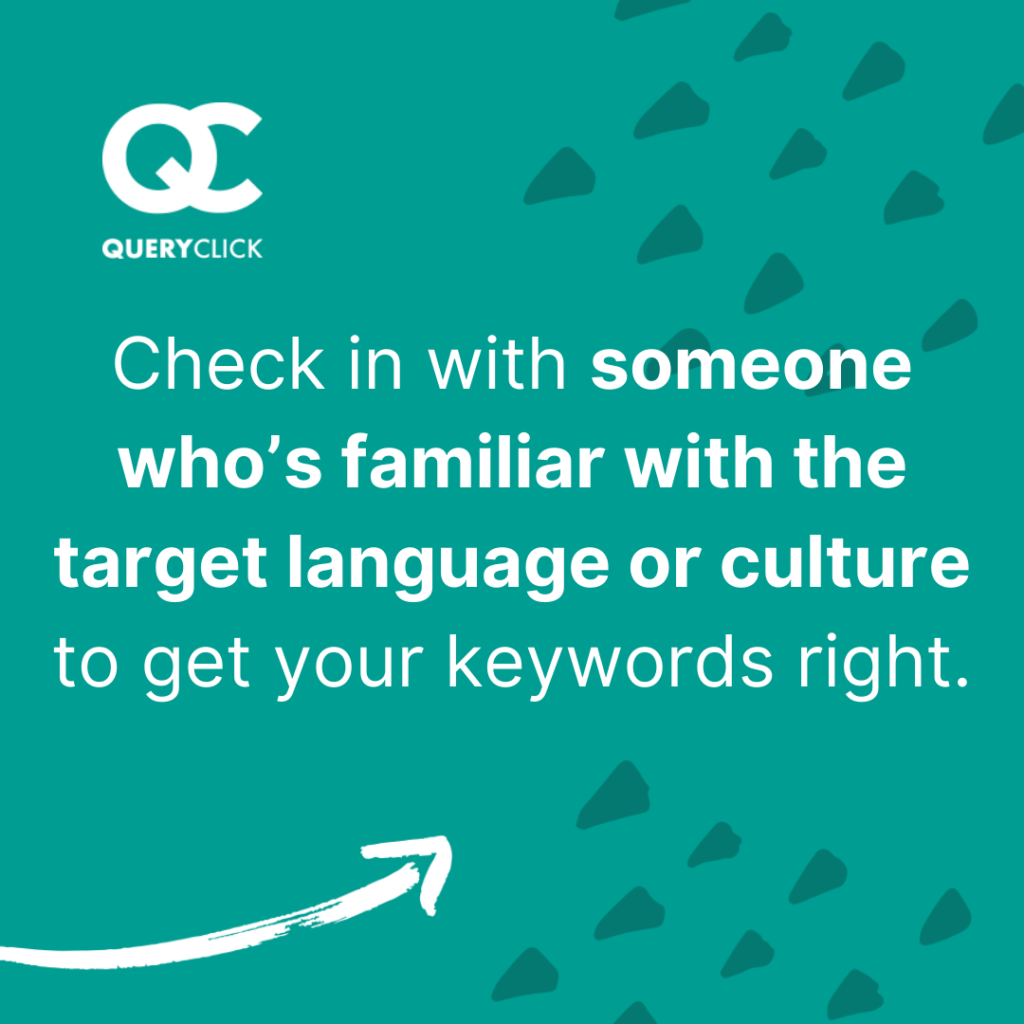
There are a few other things to be mindful of when optimising your content for a different country or culture:
- Make sure you’re familiar with local laws and regulations around consumer law and online custom
- Make sure your pricing structure reflects local currency and supply and demand
- If offering your users the ability to choose a language, don’t just rely on flags to label these – many languages are spoken in more than one country, and this can be confusing
Summary
There’s a fine art to getting international targeting right that includes having the right technical, content, and foreign-language SEO processes in place to be effective.
We’ve given you an overview of the fundamentals. If you follow all the steps above along with doing your own additional research, you’ll be well-placed to optimise your website for an international audience and boost your organic traffic abroad.
If you’re looking to expand your business into a new country or to target a new audience, get in touch and find out how we can help you today.
Own your marketing data & simplify your tech stack.
Have you read?
Chrome’s announcement on dropping cookie opt-in last month closed the door on a 5 year saga for marketers. But what is the landscape like in 2025 for cookie-based measurement?
Generative AI is transforming the way that marketers plan and assemble content for their Paid Ads. As big platforms like Google, Meta and TikTok increasingly build the tools needed to...
In a surprising move that has sparked heated debate, Mark Zuckerberg announced on his Instagram that Meta will be reducing its levels of censorship and in particular fact-checking on its...



